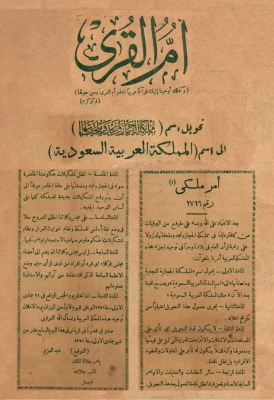
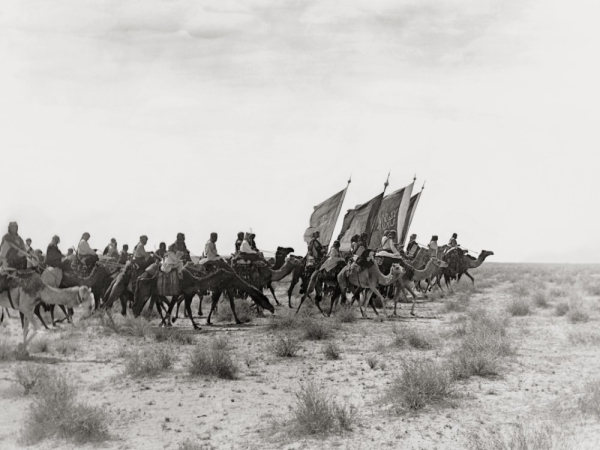
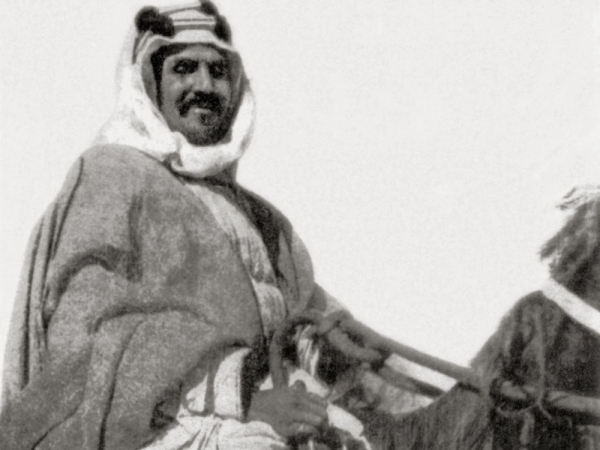
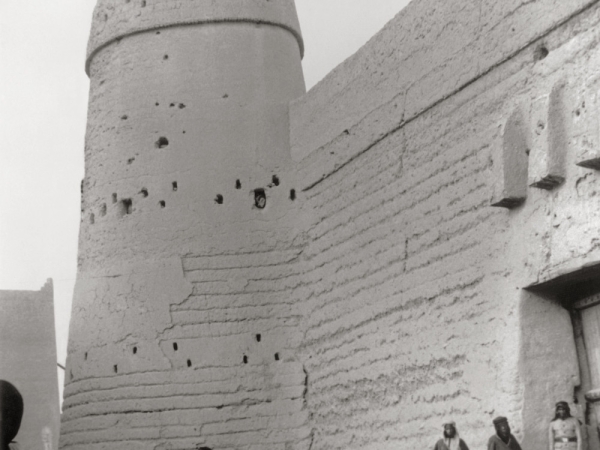
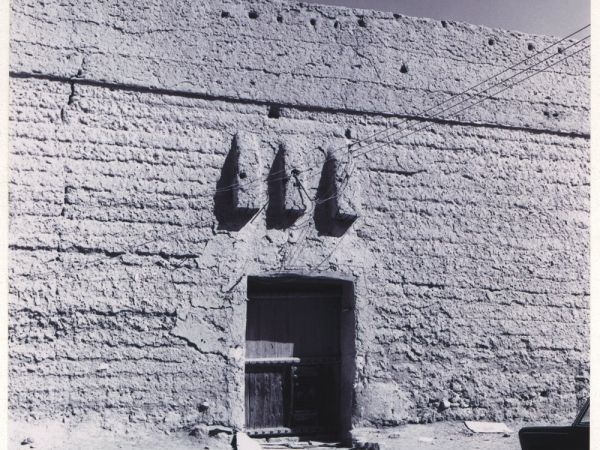
The Unification of the Kingdom of Saudi Arabia marked the re-establishment of the Saudi State. This unification began after the recapturing of Riyadh and the founding of the Kingdom by Founding King Abdulaziz Bin Abdulrahman Al Saud. He dedicated thirty-two years to unifying the country, starting his mission to recapture the core of the Saudi State just months after recapturing Riyadh.
Exiting Riyadh
During the founding stages of the Second Saudi State, it faced many external campaigns, such as the Ottoman occupation of al-Ahsa, and internal disturbances, such as Hail's separation from Saudi rule. At that time, the Emir of Hail, Mohammed Bin Abdullah Bin Rashid, a Saudi State ally, harbored aspirations to annex Riyadh, especially after besieging it for forty days. Imam Abdulrahman, dispatched his son Abdulaziz Bin Abdulrahman and a delegation of prominent figures from Riyadh to negotiate peace with him. Eventually, an agreement was reached to keep the Saudi State in Riyadh and its surroundings under the rule of Imam Abdulrahman.
Bin Rashid continued his attempts to recapture Riyadh until the end of the Second Saudi State in 1891. Al Saud family exited Riyadh to the Badiya and wandered in the desert, Qatar, Bahrain, and al-Ahsa. Imam Abdulrahman relied on his son Abdulaziz for political correspondence, sending him to request permission from the Emir of Bahrain, Sheikh Isa Bin Ali Al Khalifa, for the women of his family to stay in Bahrain, fearing for their safety due to the insecurity in the Badiya. Sheikh Isa agreed to this request.
Then, Imam Abdulrahman returned to Riyadh after organizing his army and faced Bin Rashid in Huraymila, but Imam Abdulrahman did not win the battle and returned to Badiya. King Abdulaziz was sent to al-Ahsa to negotiate with the Ottoman Empire through its governors regarding his and his family's stay there, but his request was denied. The Imam remained in the Badiya for seven months.
Imam Abdulrahman requested Sheikh Jassim Bin Thani, the Emir of Qatar, to stay there. He was welcomed and stayed in Qatar for four months until the Imam and his family moved to Kuwait in 1893, having requested the matter from the Ottoman Empire. The Imam was keen on moving to Kuwait due to its proximity to caravan routes, so he could keep informed about the situation in Riyadh and prepare for his return. These movements through the desert and the ensuing events provided King Abdulaziz with leadership experience. He learned about the temperament of the Badiya, the geography of the region, its routes and resources, and the administrative conditions of the surrounding regions. He spent most of his time in Kuwait studying ways to recapture Riyadh.
Restoration of Riyadh's rule
King Abdulaziz persisted in his efforts to recapture Riyadh, undeterred by unfavorable conditions, especially given the strained relations between Hail and Kuwait. The tension escalated further between Sheikh Mubarak and Prince Abdulaziz Bin Mutaib Bin Rashid, who assumed leadership after Mohammed Bin Abdullah Bin Rashid's passing, particularly after the Battle of Sarif. King Abdulaziz did not take part in this battle; instead, he led a campaign towards Riyadh, marking his first attempt to recapture Riyadh.
King Abdulaziz besieged al-Masmak for forty days, during which there were clashes between the two sides. He planned to dig a tunnel to enter al-Masmak Palace and began implementing his plan until he received news of Sheikh Mubarak's defeat in the Battle of Sarif. Consequently, he was forced to lift the siege on al-Masmak and withdraw from Riyadh. This was considered the first military action led by King Abdulaziz.
King Abdulaziz persistently urged his father to make further attempts to recapture Riyadh, which the Imam initially refused until Abdulaziz presented him with two plans: either you order one of your men to decapitate me or you facilitate my departure for battle in the heart of Najd. The Imam agreed, and he left Kuwait for Riyadh.
In 1901, months after his first attempt in the Battle of Sarif, King Abdulaziz set out to recapture Riyadh with forty fast-running camels, thirty rifles, SAR200, and a group of close family members and followers. Along the way, he raided tribes loyal to Bin Rashid, achieving consecutive victories that proclaimed his strength and spread his fame among the tribes. Men gathered around him, joining his ranks in preparation for entering Riyadh. After five days, he reached Hafr al-Atk and sent scouts to Riyadh to gather information on its conditions to assess the possibility of attacking. They returned with news that it was not the right time to advance towards Riyadh.
King Abdulaziz decided against entering Riyadh at that time, continuing his movements to the tribes loyal to Bin Rashid in the Badiya of Najd, winning battles against them. He distributed all the spoils among his men to support and motivate them. His raids aimed to prepare his men for recapturing Riyadh and to understand the ease of movement in areas under the Ottoman Empire's influence, particularly around al-Ahsa. He then returned with his men to al-Ahsa and stayed there for about four days before moving northward through the Sudayr Badiya and then to Banban near Riyadh. These raids increased the number of his men. The Ottoman forces tightened their grip, intensifying pressure due to scarce provisions and monitoring his movements. The numbers of his men dwindled until only those who had left Kuwait with him and twenty-three men who had joined him along the way remained.
King Abdulaziz devised a new strategy, relying on secrecy and surprise with a small group of men. He led his men to the sands of Jafurah, north of ar-Rub' al-Khali desert, aiming to stay out of sight and prepare for the march towards Riyadh. This area, devoid of inhabitants, features challenging terrain and a harsh climate. He navigated it based on memories from his early life, spent moving through ar-Rub' al-Khali with his father. He stayed with his men there for fifty days, from November to December 1901.
King Abdulaziz advanced to recapture Riyadh, aiming for al-Masmak Palace courtyard, Riyadh governor's headquarters. His strategy was to attack Ajlan, Riyadh's governor at that time, in his residence without harming the city's residents. Abdulaziz and his men stealthily entered buildings facing the palace. After securing their position, they were joined by a group of his brother Mohammed's men, who were encamped near Riyadh. At dawn on January 14, 1902, King Abdulaziz and his forces took the palace, defeated Ajlan Bin Mohammed al-Ajlan's garrison, and Ajlan along with some of his men were killed while the rest surrendered. It was declared that day that the rule belonged to Allah, then to Abdulaziz.
Pledging allegiance to King Abdulaziz as Imam of Najd
After the announcement of the restoration of Al Saud's rule and their entry into al-Masmak Palace, recapturing the homeland of his ancestors, King Abdulaziz began rebuilding the wall of Riyadh City, which had been previously demolished. He sent Nasser Bin Saud to Kuwait to inform Imam Abdulrahman of King Abdulaziz's victory and to request his assistance. A month later, Prince Saad, brother of King Abdulaziz, arrived with one hundred men and some ammunition. A number of Najd's residents joined King Abdulaziz's ranks, growing his army to approximately one thousand men.
Imam Abdulrahman arrived from Kuwait accompanied by his family. King Abdulaziz informed him that he was willing to hand over the state to his father and serve as a soldier under his command. However, the father initially refused to take over the state and passed the reign to his son. King Abdulaziz accepted the leadership on the condition that his father would provide ongoing supervision and guidance as needed. In 1902, King Abdulaziz officially took control of the rule of the state in Riyadh. His father announced his abdication and presented King Abdulaziz with the sword of Imam Saud al-Kabir, the third Imam of the First Saudi State.
Saudi Arabia's unification journey
King Abdulaziz exerted tremendous efforts in leading the unification of the Kingdom, spending thirty-two years to unify most parts of the Arabian Peninsula, which were previously separate entities. He led the people towards a new era characterized by security and stability. His lifelong struggle had a known political impact on neighboring countries at the time, and his genius and achievements have attracted the attention of authors and writers from around the world.
In the process of unifying the Kingdom, King Abdulaziz fought dozens of battles, including twenty-six battles starting with Riyadh in 1901. These battles included ad-Dilam, Faydat al-Sirr, Unayzah, al-Bukayriyyah, Shinanah, Rawdat Muhanna, al-Turufiyyah, Turubah, Hail, Taif, Jeddah, Jazan, Najran, and several other cities and regions across the Kingdom.
Al-Arid and Qassim
King Abdulaziz began the unification of the country starting with the southern regions of Najd, due to their proximity to Riyadh and the loyalty of their inhabitants to the Saudi State, in addition to being a refuge for many opponents of the Ottomans.
Recognizing the significance of Qassim Province and its role in agriculture and commerce, King Abdulaziz and Prince Abdulaziz Bin Rashid understood that it would be a decisive battleground between them. Therefore, King Abdulaziz reached out to the notables of Qassim who had fled to Kuwait to escape Bin Rashid's oppression and tyranny. They joined him in az-Zulfi region on November 20, 1903, but he delayed attacking Bin Rashid at that time, needing to stock up on animals and supplies.
King Abdulaziz headed to Qassim Province northwest of Riyadh, after annexing the region of as-Sirr to his emirate. Al Muhanna, the rulers of Buraydah, and Al Saleem family, the rulers of Unayzah, came to pledge their allegiance. In 1904, King Abdulaziz's forces attacked Unayzah and successfully annexed it to the Saudi State. In the same year, they besieged Buraydah, and the Ibn Rashid garrison led by Abdulrahman Bin Dabaan was compelled to surrender. This facilitated King Abdulaziz's annexation of all the towns in Qassim.
Bin Rashid returned to Qassim, backed by an army from the Ottoman Empire, and faced King Abdulaziz in the Battle of al-Bukayriyyah, which ended in a stalemate. However, they confronted each other again in the Battle of Shinanah. King Abdulaziz's army employed a new strategy by dividing the army into two sections; one faced Bin Rashid's army, while the other confronted the Ottoman army. This enabled King Abdulaziz's army to achieve victory in that battle.
Bin Rashid attempted another attack in 1906, advancing his army to Rawdat Muhanna east of Buraydah. However, King Abdulaziz successfully defeated and killed him, causing his army to retreat to Hail. Bin Rashid was succeeded by his son Mutaib, who made peace with King Abdulaziz. Consequently, the entire Qassim region came under the rule of the Saudi State.
Al-Ahsa and al-Qatif
In 1913, King Abdulaziz decided to recover the regions of al-Qatif and al-Ahsa and join them to the Saudi State, as they had been part of the first and second Saudi states. This move paved the way for ending the Ottoman presence in the area, which had served as their seat and had been a direct enemy of the Kingdom, supporting its opponents throughout unifying the Saudi State territories.
King Abdulaziz aimed to unify the eastern regions of the Arabian Peninsula, joining al-Ahsa to his state to extend its borders to the sea, thereby enhancing its economic significance. In 1913, he left Riyadh with a covert operation heading towards al-Ahsa. Upon reaching the city walls, his men scaled the walls and entered the city, declaring the joining of al-Ahsa into the rule of the Saudi State. The Ottoman forces retreated and surrendered, subsequently leaving for Iraq by sea. King Abdulaziz then succeeded in annexing the rest of al-Ahsa regions and al-Qatif to his state.
Aseer and Najran
Some tribal leaders from Aseer sought refuge with King Abdulaziz, expressing their dissatisfaction with Al Aidh's rule. King Abdulaziz reached out to Hasan Bin Ali Al Aidh to address the situation in Aseer, but he refused, prompting King Abdulaziz to dispatch an army led by Prince Abdulaziz Bin Musaid Bin Jalawi. They met in the Battle of Hijla in 1920, and Prince Abdulaziz managed to enter Abha and annex it up to the western borders of the Sulaimaniyah district. Additionally, King Abdulaziz sent several expeditions that reached Najran, leading to its unification. However, Hasan Bin Ali Al Aidh later revolted, attacked Abha, and took control of it during King Abdulaziz's campaigns in Hail. After completing the annexation of Hail to the Saudi rule, King Abdulaziz sent an army led by his son, Prince Faisal (later King Faisal), in 1922, and successfully reinstated Aseer under Saudi rule.
Hail
Between 1915 and 1919, the outskirts of Hail witnessed military maneuvers by King Abdulaziz's forces, and fighting renewed between him and Bin Rashid due to Al Rashid's breach of the peace treaty between them and King Abdulaziz. The latter had no choice but to confront Al Rashid's army. Several battles took place, including the Battle of Jarrab near az-Zulfi Governorate. King Abdulaziz sent his forces many times to Hail, and in the last expedition, they continued to besiege it for two months until it surrendered and joined his rule in 1921.
Hejaz
In the first battles for the recovery of the Hejaz region, King Abdulaziz triumphed over the forces of Sharif Hussein Bin Ali in Turubah, where he stayed for ten days managing its affairs before appointing an Emir from his side to govern and returning to Riyadh. Sharif Hussein banned Najdis from performing Hajj in the following years. This prompted King Abdulaziz to recover Taif by military force, followed by the peaceful entry into Makkah in 1924, and subsequently al-Madinah al-Munawwarah a year later, both coming under Saudi rule.
Events started when King Abdulaziz sent his forces led by Sultan Bin Bajad towards the western regions of the Arabian Peninsula to support Khalid Bin Luai, the Emir of Turubah, who declared his adherence to King Abdulaziz's rule. The forces of Sharif Hussein Bin Ali, led by his son Abdullah Bin Hussein, attacked Turubah and wreaked havoc upon its inhabitants. However, this did not last long, as Sultan Bin Bajad and Khalid Bin Luai launched a sudden and massive attack in 1919, resulting in the defeat of Sharif Hussein's forces, with only a few survivors. Following King Abdulaziz's victory in Turubah, he began heading towards the Hejaz.
In retaliation for his loss in the Battle of Turubah, Sharif Hussein prevented the Najdi pilgrims from performing Hajj. Consequently, King Abdulaziz convened the Riyadh Conference in 1924, chaired by his father Imam Abdulrahman Bin Faisal, with the participation of scholars and leaders from both urban and Bedouin areas to consult on the matter of preventing the Hajj for the Najdis. It was decided that the Najdis would proceed with Hajj despite the prohibition. Subsequently, King Abdulaziz sent an army consisting of fifteen brigades to the Hejaz in 1925 and succeeded in annexing Taif to the rule of Al Saud after defeating Sharif Hussein's forces.
Then the forces of King Abdulaziz headed towards Makkah al-Mukarramah, as at that time Sharif Ali Bin al-Hussein had left it for Jeddah. The Saudi army members entered Makkah al-Mukarramah peacefully, in a state of Ihram, without war, awaiting the arrival of King Abdulaziz. The latter departed from Riyadh with a group of knights and an entourage consisting of princes, scholars, and dignitaries from both urban and Bedouin communities. Fifteen battalions joined him on the way, and he would stop for a day or two at some locations to receive delegations from tribes. This journey lasted for twenty-five days. On December 3, 1924, he entered Makkah al-Mukarramah in the state of Ihram to perform Umrah and stayed there for about a month before heading to Jeddah.
In the same year, King Abdulaziz completed the unification of the regions of the Hejaz. The cities of al-Lith and al-Qunfudhah peacefully came under his rule. His forces besieged Jeddah City for over a whole year after Sharif Hussein Bin Ali and his forces fortified themselves within it. Meanwhile, he dispatched detachments to the north of the Hejaz towards al-Madinah al-Munawwarah and its surrounding cities to incorporate them into his rule. He entered al-Madinah al-Munawwarah peacefully, similar to what had happened in Makkah al-Mukarramah. Then, Ali Bin al-Hussein surrendered and sought reconciliation, leading to the signing of the Jeddah Agreement in 1925. Thus, King Abdulaziz unified all parts of the Hejaz with the Saudi state. He was proclaimed the King of Hejaz on Friday, January 10, 1926, in the Grand Mosque following the Friday prayer near the Bab as-Safa, thus becoming the Sultan of Najd and the King of Hejaz.
Jazan and Tihama Aseer
King Abdulaziz completed the unification campaigns in Jazan region and Tihama Aseer in the southwest of the Arabian Peninsula after these lands remained under his protection for four years by virtue of the Treaty of Makkah al-Mukarramah, which was concluded between the founding king and al-Hassan al-Idrisi on October 21, 1926. The founding king sent his forces there, and al-Hassan relinquished control to him. In 1926, Jazan became part of the Saudi State and was fully handed over to the administration of King Abdulaziz in 1930.
Establishment of the modern Saudi entity
Stages of naming the state
During the stages of its establishment, the Kingdom was given several names. As a result, King Abdulaziz was bestowed with various titles. Initially, he was known as the Prince of Najd and the leader of its tribes in 1902. Later, he became the Sultan of Najd and its dependencies in 1920. Upon annexing the Hejaz to his rule, he became the King of Hejaz and Sultan of Najd and its dependencies in 1926. A year later, in 1927, he became King of Hejaz and Najd and its dependencies. Upon the successful unification of the Kingdom, he became the King of the Kingdom in 1932.
Announcement of the unification of Saudi Arabia and its naming
King Abdulaziz was able to unify the parts of the country under his rule, and consolidate its cities and villages on September 18, 1932. A Royal Order was issued to announce the unification of the country and name it the Kingdom of Saudi Arabia, starting on Thursday, September 23, 1932. It was declared a fully sovereign Arab state, with Islam as its religion, Arabic as its language, Riyadh as its capital, and the Quran and the Sunnah of the Prophet as its constitution.
When King Abdulaziz completed the unification of the Kingdom, he said: I have been granted dominion over this land under the authority of Allah, then the Arab values. Every member of my people is a soldier and a policeman, and I stand among them as an equal. I do not prefer myself over them, and I do not rule except what is good for them.
System of rule in Saudi Arabia
Monarchy is the system of rule, and the rulers of the country are amongst the sons of the Founder King Abdulaziz Bin Abdulrahman Al Saud, and their descendants. The most upright among them receives allegiance according to Almighty Allah's Book and His Messenger's Sunnah. The invitation to pledge allegiance to the king and to choose the crown prince is conducted according to the Allegiance Council Law. The crown prince devotes himself exclusively to his duties as crown prince and performs any duties delegated to him by the king. Upon the death of the king, the crown prince assumes the royal powers until a pledge of allegiance is given. The system of rule in the Kingdom derives its powers from the Quran and the Prophetic Sunnah.
Saudi National Day
The Kingdom celebrates on September 23 of each Gregorian year the anniversary of the declaration of its unification, marking it as an official holiday. This significant historical day in the Saudi calendar is officially recognized by the government and endorsed by the Royal Court as an article within the state's official regulations. Local congratulatory messages are conveyed on this day to the Custodian of the Two Holy Mosques and his Crown Prince. It is also celebrated by the national entity of the Gulf Cooperation Council countries and Arab states.
On the National Day, the Saudi national flag is raised on all government buildings. Fireworks and national parades are launched, and official speeches and national celebrations take place in all regions of the Kingdom.
Related quizzes

